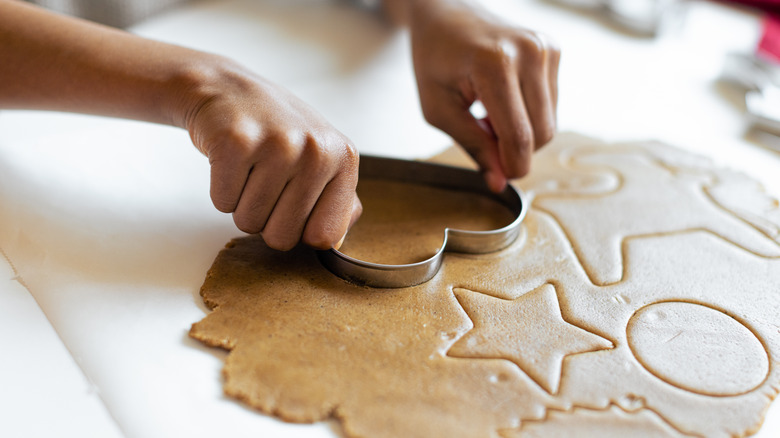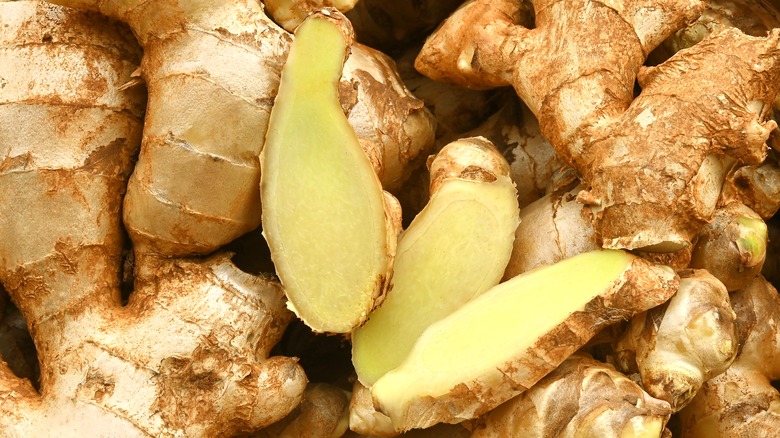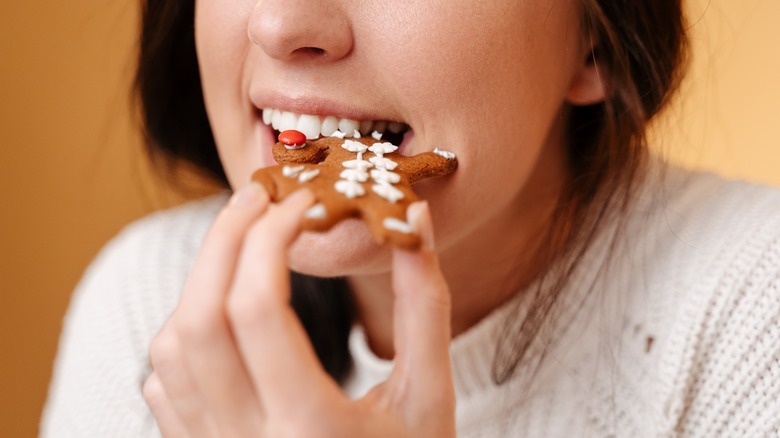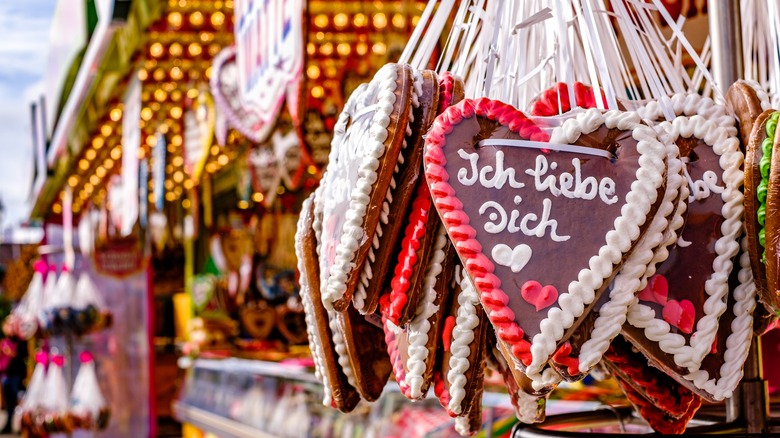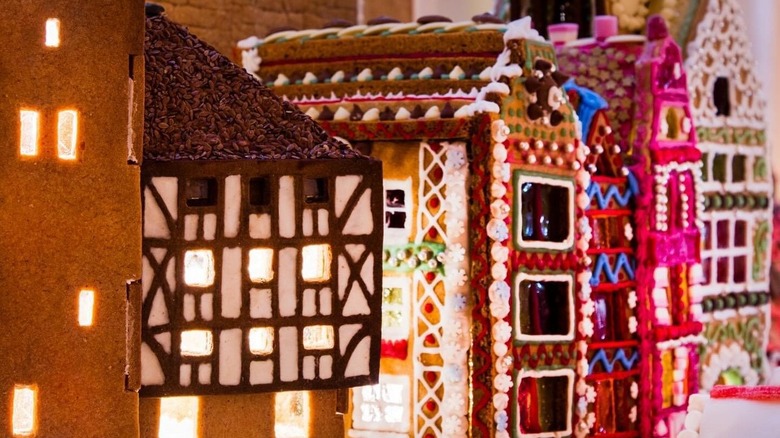What Is Gingerbread And Why Is It Typically Eaten During The Holidays?
Every holiday season, we're face first into that sugar, spice, and everything nice. And by everything nice, we mean literally all of the gingerbread. So what the heck is it? And why are we in a serious yuletide relationship with the stuff? Well, it's not our favorite seasonal food group for nothing.
We all love our signature recipes, baked up as gingerbread people with iced button eyes, or a warm slice of bouncy, spiced gingerbread cake (Ugh, stop it right now. Is there anything more perfect as an afternoon treat with coffee?), and even as gingerbread houses. But, for real, calling them "houses" is putting it lightly, considering the competitive fever around this activity. (However the end result turns out, it gets Gram'd or TikTok'd — or it didn't happen!)
Newsflash: This ginger's got roots. We're taking it all the way back to the 24th century B.C. to unearth those gyngerbrede beginnings, and fast-forwarding all the way through "Hansel and Gretel" to the annual Gingerbread City popup. What do Queen Victoria's dog, Barbie, and a 36 million-calorie house have in common? Whatever happens, we're not leaving without the gingerbread!
Yia-Yia's original recipe
With plenty of old-fashioned, classic, or traditional gingerbread recipes floating around, it's obvious that gingerbread isn't a recent invention. But just how old is it? Well, the first recipe we know about was from Greece — maybe even from a grandma, we don't know. And sweet, precious Yia-Yia managed to type it into the Notes app on her phone (wink-wink) way back in 2400 B.C.
The recipe really does go back that far. But the term "gingerbread" has since evolved to include any dessert type treat that features these elements: ginger, molasses, honey, or treacle (It's like the British version of molasses, and it's what's leftover after you boil sugar cane to make granulated sugar. "The Great British Bake Off" makes so much more sense now).
Extremely confusing, however, is the fact that the earliest recorded English recipe for gingerbread — or gyngerbrede as they spelled it back in the 1400s — had zero ginger in it! Instead, it called for boiled honey, saffron, powdered pepper, cinnamon, cloves, and a type of red food coloring suspiciously achieved through the addition of finely ground tree bark. (Uh ... is this dessert or punishment?) Appreciate you, early gyngerbrede adopters, but also never going back to coloring food with sawdust.
Ginger: not just a Spice Girl
The long history and enduring popularity of gingerbread almost certainly points back to the starring ingredient itself: Ginger root. Shimmering with antioxidants like shogaols, zingerones, and gingerols (Hello, are these even real words? Also pretty sure it's not pronounced zin-jer-OH-neez like we hope), ginger might just be the world's first superfood. Whatever, who cares if "superfood" was originally a made-up marketing term to sell bananas! Ginger spice forever!
Originally a gift from the gods, ginger root as farm produce became a thing in ancient China. People back then used it as a medicine (geniuses of their time). It was also sort of a condiment of the Middle Ages, often paired with preserved meat to smooth out the (gag) flavor and make it go down a little easier. England's King Henry VIII swore that ginger root could ward off the plague. For the record, he died in 1547 of not-the-plague.
Totally ripping off all of these historical facts and pretending we thought of it ourselves, we still use ginger these days to remedy nausea and indigestion. Many of us use it to quell motion sickness, morning sickness, and even lessen the side effects of chemotherapy. That's why ginger ale, ginger candy, and ginger teas are often recommended as a home remedy for moving digestion along, posthaste. But enough about plain ol' ginger root. Let's get to that bake!
High status carbs
While your eyes might bug out at the price of saffron, or Madagascar vanilla, most spices are easy to chuck into your shopping cart. Of course, that wasn't the case in medieval times. Back then, spices were bling. (It was the Dark Ages. They obviously had nothing to do on the weekend, except freak out about Everything Bagel spice.) If you got your grubby little hands on a little bit of cinnamon, you sure as heck were gonna show it off like a new Lambo in the driveway. And what better way to do it, than with gingerbread which showcases a bunch of expensive spices at once, you medieval Tiffany & Co.! Bonus, it was typically eaten at the end of a meal, to help digestion and freshen the breath. More gingerbread, anyone?
Gingerbread biscuits and cookies made their way into the shape of humans thanks to Queen Elizabeth I, who, y'know, gets the credit for basically inventing gingerbread people. As a way of honoring visitors to the kingdom, she commissioned gingerbread cookies to look like her guests. There was also the voodoo-like superstition that if a gingerbread man was eaten by a young lady, she would totally be getting married, you guys. No word on whether you're supposed to eat the face, an arm, or a leg first.
Bread, but like, fun bread
Here's where we get this holiday spice party started. In the 1900s, no one went to the county fair for funnel cake, fried Oreos, and spinning around on the Alien Abduction ride until you hurled your corn dog. No, no, no — people went for the gingerbread cookies! And probably the livestock parades and contests to see who could plow the best.
Along with the sweet factor, cookie society considered it lucky to eat gingerbread biscuits from the local carnival. Of course, these particular cookies were feeling themselves, delightfully adorned with images of royal personalities, sweet icing, and (party!) gold leaf. It was a whole thing.
During the winter season, gingerbread cookie decoration was amped up even more, with the addition of seasonal shapes like reindeer and stars. And over in Germany, bakers understood the assignment and dutifully hung their cookies on trees (hey-oh, this is sounding pretty Christmassy!) along with candy and pastry as part of a fun holiday display. It was especially fun since they were often pre-dipped in a little vino.
But first, Christmas
Sleigh! We can all thank the Brits for going full yule on their gingerbread and turning it into a beloved seasonal trend. It was probably just as popular as pumpkin spice. But with ginger. And with no one misspelling your name on the cup.
Once again we look to the royal family for the latest in gingerbread fashion. Legend has it that Queen Victoria gifted her King Charles Spaniel Dash a bit of gingerbread (with holly and candles as decoration, because of course) for Christmas as early as 1883. Her hubby, Prince Albert, got the party started by throwing on a Santa costume and handing out gingerbread and apples to the kids. 'Twas a simpler time, when apples were the Playstation 5 of gifts.
For the rest of us commoners, a yeasted pepper cake was often shared with anyone annoying the neighbors by going around and singing Christmas carols. Pepper cake was a form of celebratory gingerbread requested in the children's rhyme, "A little bit of pepper cake, a little bit of cheese, a cup of cold water, and a penny if you please." Apparently the cheese perfectly complemented the cake. Not gonna lie, minus the penny, that sounds like yummypants.
Yeah, but make it a house
Long before they invented Adidas sneakers, gummy bears, nuclear fission, and the Volkswagen Beetle — but, after they invented the Christmas tree in 1419 — Germans engineered gingerbread in the shape of a house, in the 16th century. And while they get the nod for doing it, the reason why the trend took off is a little more mysterious.
There is a story that hints at the Brothers Grimm fairytale "Hansel and Gretel" for making gingerbread houses a total fan favorite. Apparently, instead of feeling alarmed by the evil witch character's house (originally made of bread, cake, candy, and sugar), everyone in the 1800s was like, "OMG, you know what would be cool is if we made little replica witch houses out of gingerbread." The witch's house even morphed into a straight-up gingerbread version as the story passed through history.
A quick shout out to the regular, non-fairytale people who took the winter season tradition of gingerbread cookies and ran with it. They saw those festive bakers' window displays, and soon began hanging little gingerbread houses on their own Christmas trees — and giving the tiny dwellings as gifts. And, 200 years later, we seem to have no problem treating ourselves to our own gingerbread.
That g-bread life
"Come on, Barbie, let's go party!" These days, we're proud to say we have our gingerbread house obsession on lock. When it comes to the hottest holiday digs on the market, you have two choices: Hustle in the kitchen baking your own gingerbread from scratch, or snag a kit featuring just about any theme you like. We'll take door number two.
Heck yeah, you can get a Barbie Dreamhouse gingerbread kit! Of course, there is also the well-appointed Candyland kit, several minimalist mid-century modern gingerbread house kits, and an entire slew of movie themed kits. Ditch the jingle bells and go full psychological thriller with the "Hereditary" movie gingerbread house kit — complete with the gingerbread version of Peter, Paimon, and the worshiper characters.
Of course, not every gingerbread house has to be the kind you can eat. Bergdorf Goodman will sell you a $1,950 Victorian gingerbread house that couldn't possibly hold any more glass candy. You can even decorate yourself with a zip-up gingerbread person onesie! And for Christmas sake, don't leave your pup out in the cold. Pick up a ridiculously adorable gingerbread dog costume for the best ever photo with Santa Paws.
Sweetest house on the market
Speaking of edible real estate, one gingerbread house was so freakin' big it needed an actual city building permit. Still considered the world's biggest gingerbread house as of 2023, the 2,500 square foot behemoth was human-sized, and available to tour in Bryan, Texas. (You could also get pics with Santa!)
Built in 2013, thanks to a collaboration between Traditions Club and the St. Joseph Health System, the delicious spectacle raised $200,000 for the hospital's Level II Trauma Center. And, other than a wooden frame, you could eat the whole thing. What does a day in the life of that spectacular diet look like? Let us tickle your mind grapes.
For this life sized gingerbread house, the Guinness Book of World Records verified the use of 7,200 pounds of flour, 1,800 pounds of butter, 7,200 eggs, 3,000 pounds of brown sugar, 225 gallons of molasses, and more than 22,000 individual candies. If you could demo the entire thing with your face, you'd be eating a record-breaking 35,823,400 calories! Not that we're counting. (But do you get a t-shirt and your picture on the wall?) We're unclear on whether the world's biggest gingerbread man, Smitty, ever made it from Smithville, Texas to his gigantic dream home just an hour away from where he was created.
Gingerbread city
Welcome to the future, where everything is gingerbread and you can eat all the walls and no one's ever sad. Well, maybe you're not really supposed to eat The Gingerbread City, but it's as close as we can get for the holiday season.
Behold a candified gingerbread-themed architecture popup that appears in New York City and London from late November through early January every year. With gingerbread house making workshops every day (of course you take yours home!), the edible city features moving parts, teetering towers, and whirly bits built by actual architects and designers. Plus, the Big Apple outpost commissioned SoHo's most iconic French eatery, Balthazar, for all that spicy gingerbread.
Of course, you could skip the lines and visit a "real" gingerbread-style city: medieval Dinkelsbühl, Germany. (Wait a minute, a gingerbread town in Germany, where gingerbread houses were invented? It's a full circle moment.) With perfectly preserved colorful, 400-year-old houses, cobblestone streets, and Gothic-style cathedrals, you'll go home with plenty of inspiration for your next gingerbread house-making party. Pass the peppermints! We've got some patio furniture to build so our gingerbread people can live their best lives before their roof caves in.


